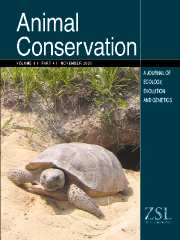Crossref Citations
This article has been cited by the following publications. This list is generated based on data provided by
Crossref.
Schulze, Christian H.
Waltert, Matthias
Kessler, Paul J. A.
Pitopang, Ramadhanil
Veddeler, Dorthe
Mühlenberg, Michael
Gradstein, S. Robbert
Leuschner, Christoph
Steffan-Dewenter, Ingolf
and
Tscharntke, Teja
2004.
BIODIVERSITY INDICATOR GROUPS OF TROPICAL LAND‐USE SYSTEMS: COMPARING PLANTS, BIRDS, AND INSECTS.
Ecological Applications,
Vol. 14,
Issue. 5,
p.
1321.
WALTERT, MATTHIAS
MARDIASTUTI, ANI
and
MÜHLENBERG, MICHAEL
2004.
Effects of Land Use on Bird Species Richness in Sulawesi, Indonesia.
Conservation Biology,
Vol. 18,
Issue. 5,
p.
1339.
Donald, Paul F.
2004.
Biodiversity Impacts of Some Agricultural Commodity Production Systems.
Conservation Biology,
Vol. 18,
Issue. 1,
p.
17.
Waltert, Matthias
Bobo, K. Serge
Sainge, N. Moses
Fermon, Heleen
and
Mühlenberg, Michael
2005.
FROM FOREST TO FARMLAND: HABITAT EFFECTS ON AFROTROPICAL FOREST BIRD DIVERSITY.
Ecological Applications,
Vol. 15,
Issue. 4,
p.
1351.
Muñoz, David
Estrada, Alejandro
Naranjo, Eduardo
and
Ochoa, Susana
2006.
Foraging ecology of howler monkeys in a cacao (Theobroma cacao) plantation in Comalcalco, Mexico.
American Journal of Primatology,
Vol. 68,
Issue. 2,
p.
127.
Matlock, Robert B.
and
Edwards, Peter J.
2006.
The Influence of Habitat Variables on Bird Communities in Forest Remnants in Costa Rica.
Biodiversity & Conservation,
Vol. 15,
Issue. 9,
p.
2987.
O'DEA, NIALL
WHITTAKER, ROBERT J.
and
UGLAND, KARL I.
2006.
Using spatial heterogeneity to extrapolate species richness: a new method tested on Ecuadorian cloud forest birds.
Journal of Applied Ecology,
Vol. 43,
Issue. 1,
p.
189.
O’Dea, Niall
and
Whittaker, Robert J.
2006.
Vertebrate Conservation and Biodiversity.
Vol. 5,
Issue. ,
p.
305.
King, David I.
Hernandez-Mayorga, Martin D.
Trubey, Richard
Raudales, Raul
and
Rappole, John H.
2006.
Vertebrate Conservation and Biodiversity.
Vol. 5,
Issue. ,
p.
473.
Barlow, Jos
Mestre, Luiz A.M.
Gardner, Toby A.
and
Peres, Carlos A.
2007.
The value of primary, secondary and plantation forests for Amazonian birds.
Biological Conservation,
Vol. 136,
Issue. 2,
p.
212.
O’Dea, Niall
and
Whittaker, Robert J.
2007.
How resilient are Andean montane forest bird communities to habitat degradation?.
Biodiversity and Conservation,
Vol. 16,
Issue. 4,
p.
1131.
Franzen, Margaret
and
Borgerhoff Mulder, Monique
2007.
Ecological, economic and social perspectives on cocoa production worldwide.
Biodiversity and Conservation,
Vol. 16,
Issue. 13,
p.
3835.
Faria, Deborah
Paciencia, Mateus Luís Barradas
Dixo, Marianna
Laps, Rudi Ricardo
and
Baumgarten, Julio
2007.
Ferns, frogs, lizards, birds and bats in forest fragments and shade cacao plantations in two contrasting landscapes in the Atlantic forest, Brazil.
Biodiversity and Conservation,
Vol. 16,
Issue. 8,
p.
2335.
RILEY, ERIN P.
2007.
The Human–Macaque Interface: Conservation Implications of Current and Future Overlap and Conflict in Lore Lindu National Park, Sulawesi, Indonesia.
American Anthropologist,
Vol. 109,
Issue. 3,
p.
473.
Oke, D.O.
and
Odebiyi, K.A.
2007.
Traditional cocoa-based agroforestry and forest species conservation in Ondo State, Nigeria.
Agriculture, Ecosystems & Environment,
Vol. 122,
Issue. 3,
p.
305.
Vaughan, Christopher
Ramírez, Oscar
Herrera, Geovanny
and
Guries, Raymond
2007.
Spatial ecology and conservation of two sloth species in a cacao landscape in limón, Costa Rica.
Biodiversity and Conservation,
Vol. 16,
Issue. 8,
p.
2293.
King, David I.
Hernandez-Mayorga, Martin D.
Trubey, Richard
Raudales, Raul
and
Rappole, John H.
2007.
An Evaluation of the Contribution of Cultivated Allspice (Pimenta Dioca) to Vertebrate Biodiversity Conservation in Nicaragua.
Biodiversity and Conservation,
Vol. 16,
Issue. 4,
p.
1299.
Bisseleua D. Hervé B.
and
Vidal, Stefan
2008.
Plant biodiversity and vegetation structure in traditional cocoa forest gardens in southern Cameroon under different management.
Biodiversity and Conservation,
Vol. 17,
Issue. 8,
p.
1821.
ABRAHAMCZYK, STEFAN
KESSLER, MICHAEL
DWI PUTRA, DADANG
WALTERT, MATTHIAS
and
TSCHARNTKE, TEJA
2008.
The value of differently managed cacao plantations for forest bird conservation in Sulawesi, Indonesia.
Bird Conservation International,
Vol. 18,
Issue. 04,
p.
349.
Rice, Robert A.
2008.
Agricultural intensification within agroforestry: The case of coffee and wood products.
Agriculture, Ecosystems & Environment,
Vol. 128,
Issue. 4,
p.
212.


